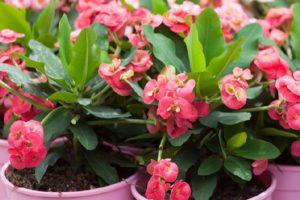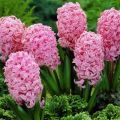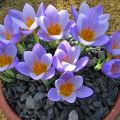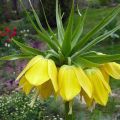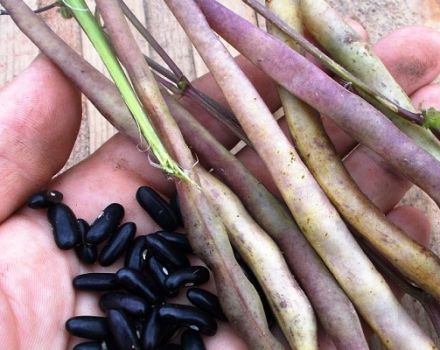How to plant hyacinths for distillation at home, choice and storage rules for bulbs
Forcing hyacinths at home will allow you to please loved ones with bright lush flowers for the spring holidays. For this, it is important to follow the forcing process and choose the right planting material. The plant has many varieties, it is important to choose the right variety for growing at home.
Forcing hyacinths at home
To grow hyacinths at home, you need to choose the right time and plant variety. It is also required to comply with all growing conditions and rules. If you carry out all the stages correctly, then the plant will certainly delight you with its lush flowers.
Choosing the bulbs
The selection of bulbs is carried out in the summer. The strongest flowering plants are dug up two weeks earlier. For planting at home, select specimens with a diameter of at least 5 centimeters. So they choose planting material from their own site.
Hyacinths can also be purchased at flower shops. They are sold all year round. Choose strong, large bulbs. They must be intact, without cracks, mechanical damage, uncharacteristic stains and rot.
The following varieties are selected for early distillation:
- Amsterdam;
- Anna Marie;
- Bismarck;
- Ostara;
- Myosotis.
Their flowering can be stimulated by the end of December.
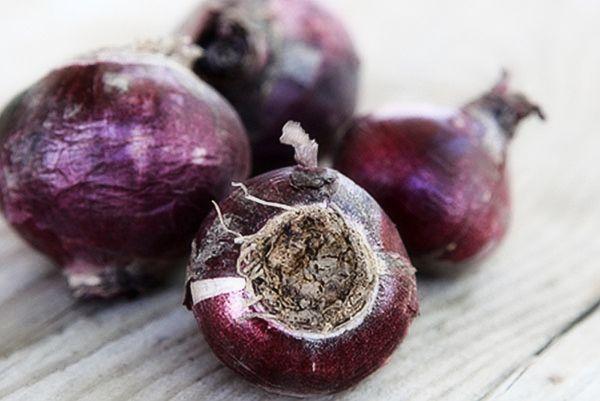
By mid-February, the following varieties will bloom:
- Amethyst;
- Blue Jacket;
- Lady Derby;
- Tubergens Scarlet;
- Carnegie.
To get blooming hyacinths by the beginning of March, varieties are chosen:
- Woodstock;
- Gertrude;
- Snow Crystal;
- Hollyhock;
- Anna Lisa.
Preparation and storage rules for bulbs before planting
The specimens collected from the flower bed are dried in the air, in the shade. For two weeks they are kept at a temperature of 28-30 ° C, then the same period of time is kept at a temperature of 16-18 ° C. The transition to a new temperature regime is carried out smoothly.
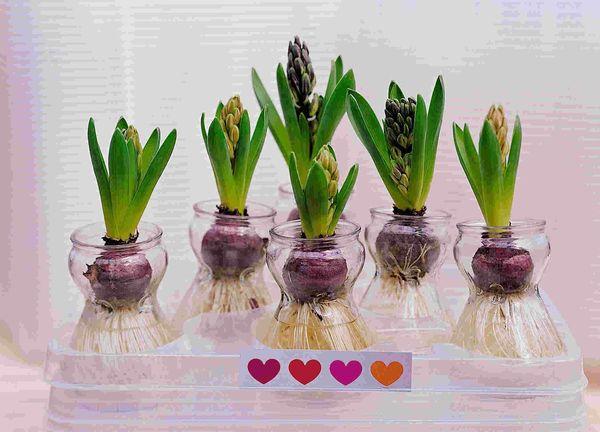
Until planting, the bulbs are stored in a well-ventilated room at a temperature of 17 ° C. It is important to correctly observe the terms and conditions for collecting planting material. Hyacinth is picky about them, if you break them, then flowering will be poor.
Important! Holding at certain temperatures plays an important role in the subsequent distillation.
We select the capacity
For planting one specimen of hyacinths, a pot for indoor plants with a diameter of 10 centimeters and the same depth is suitable. If you want to create a composition of several bulbs, take wide and shallow pots. When planting several plants, you need to distribute them so that they do not come into contact with each other and do not touch the walls of the container.An important point is the presence of a drainage hole in the pot and a pallet for it. Drainage is necessary to prevent decay of the planting material.
Preparing the soil
For hyacinths, mix 3 parts of peat and 1 part of sand. If the earth is acidic, then dolomite flour is added. The use of fertilizers in this case is not appropriate, since the bulb accumulates all the necessary nutrients for germination.
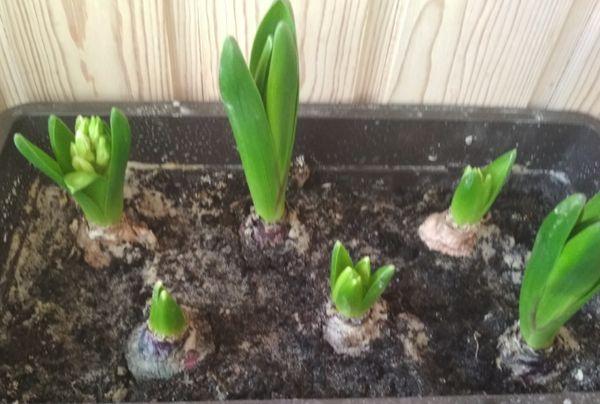
You can also purchase ready-made primer at flower shops. In addition to soil, you need to think about creating a drainage layer at the bottom of the pot.
Planting a plant
After determining the growing period and varieties, planting in a pot is carried out. The process takes place in the following stages:
- The bulbs are soaked in a solution of potassium permanganate for 7-10 minutes.
- Drainage material is laid at the bottom of the pot: expanded clay, small stones, moss.
- The drain is covered with a small layer of sand.
- The pot is half covered with soil.
- Lay the onion on top.
- Sprinkle it with the remains of soil, so that 2-3 centimeters protrude above the ground.
- Gently tamp the soil with your fingers so that there are no gaps filled with air.
- Sprinkle on top with a small layer of sand.
- Sprinkle with warm water.
- After the hyacinths are planted, they begin to cold accelerate root formation.
Important! When placing several copies in a pot, a distance of 2-2.5 centimeters is maintained between them.

If babies have formed on the bulb, then they are carefully removed, since they interfere with the development of the main plant. Hyacinth spends its forces on it, which are used to form flowers.
Cold acceleration
After planting, hyacinths are moved to a cool place to accelerate growth. A glazed balcony is perfect for this process. The place should be well ventilated, the temperature should be kept around 8 ° C. For cold acceleration, light is limited to the bulbs. The pot is covered with thick paper or dark cellophane. Several holes are made for air circulation.
The pot is left on the balcony for 10-16 weeks. Watering should be monitored periodically. If the soil is dry, then watered, if wet, then no. Hyacinths should not be poured, this will cause the bulb to rot.
If there is a need to accelerate root germination, then before the start of cold acceleration, the planting material is dipped into the root former solution. The bulbs are kept in it for 2 weeks, then they are planted.
Move the flower pot to a warm place
After cold acceleration, a sprout of 2-2.5 centimeters is formed. The temperature is gradually raised to 18-22 ° C. Remove the protective cap from the sun and provide the flower with 10 hours of daylight. When using a special lamp, it is placed 50 cm above the plant.

The plant will gradually grow and blossom. During the period of bud formation and flowering, the flower needs abundant and regular watering. Water the hyacinth in small doses every day. Water is used at room temperature, previously separated.
After 3-4 weeks, the plant blooms.
The nuances of forcing hyacinths in water
Hyacinths can also be potted with water. To do this, you need to follow a few rules:
- Choose a container with a narrow neck so that the bulb does not touch the water. If such utensils are not available, use cardboard linings on the neck.
- Activated carbon is placed in the water so that the water does not deteriorate.
- Periodically, water is added as it evaporates.
- Plants are stored in this form in the refrigerator until it sprouts 3-4 centimeters long.
- Then it is transferred to a cool windowsill.
- After the formation of a strong stem, it is transferred to a warm room and buds are expected to form.
Resuscitation of bulbs
After distilling hyacinths at home, the planting material is depleted and is considered not suitable for further use. Usually the used bulbs are thrown away. But there are several options for restoring instances.
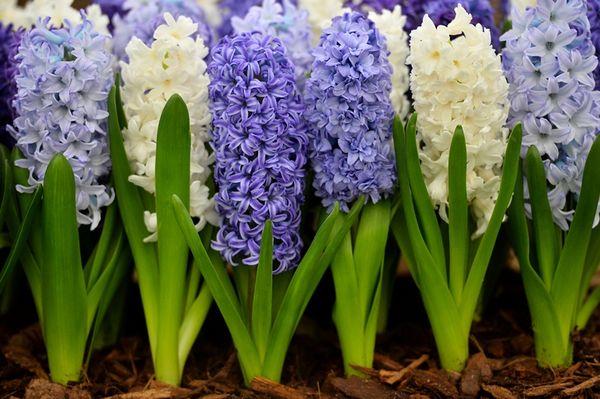
What to do with hyacinth after flowering
To restore the damaged bulb, the following manipulations are performed:
- Remove flowers after flowering.
- Feeding is carried out with mineral fertilizers.
- The plant is further illuminated and the flower is left at room temperature.
- After a week, watering is reduced, the hyacinth is transferred to natural light.
- After the leaves begin to dry, watering is completely stopped.
- The pot is placed on its side to remove excess liquid, and left in this form for several days.
- After the leaves have completely died off, the bulb is taken out and left at a temperature of 17 ° C, until the next planting.
- The next planting is best done outdoors, so that the bulb is fully restored.
- Large specimens are used for re-forcing, but the flowering will not be lush and plentiful as the first time.

